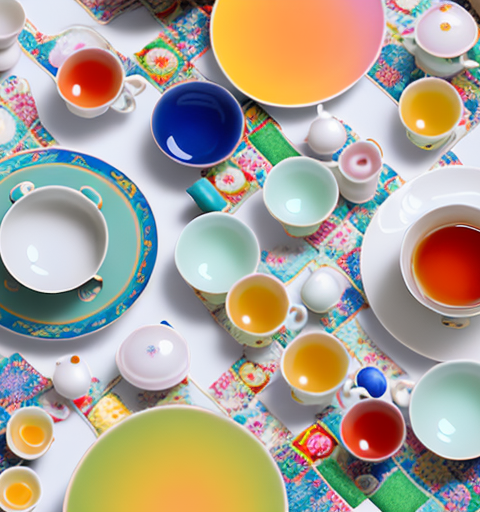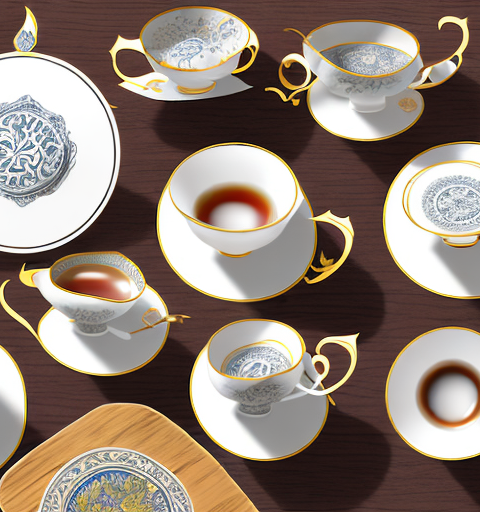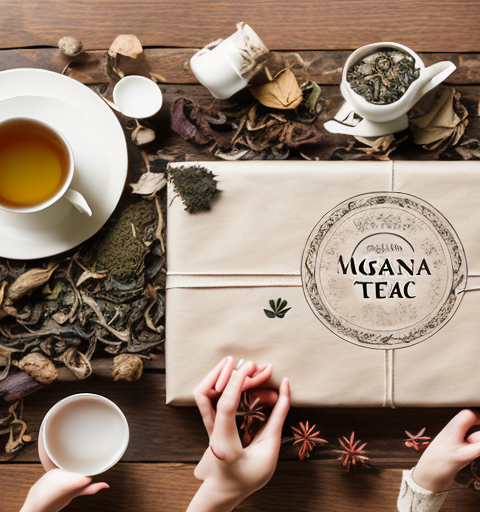Tea stains can be a common problem when it comes to maintaining the cleanliness of a teapot, especially if it has a beautiful hand-painted design. The ceramic body of a teapot is prone to absorbing the tannins present in tea, leaving behind unsightly stains. However, with the right tools and techniques, these stains can be easily removed, allowing your teapot to regain its original appearance.
Understanding the importance of maintaining a clean teapot
Maintaining a clean teapot is vital not only for aesthetic reasons but also for ensuring the purity of the tea you brew. Tea stains can alter the taste of subsequent brews, leading to a less enjoyable tea-drinking experience. Additionally, neglecting to clean your teapot regularly can promote the growth of bacteria and mold, which can be harmful to your health. By taking the necessary steps to remove tea stains from your teapot, you not only enhance its visual appeal but also preserve the quality of your tea.
Furthermore, a clean teapot can also improve the longevity of your teapot. Tea stains can build up over time and cause the material of the teapot to deteriorate. Regular cleaning helps to prevent this and ensures that your teapot remains in good condition for years to come. Additionally, a clean teapot is less likely to develop any unpleasant odors that can affect the aroma of your tea. By maintaining a clean teapot, you can enjoy a fresh and flavorful cup of tea every time.
The challenges of removing tea stains from a hand-painted teapot
Removing tea stains from a hand-painted teapot can be more delicate and challenging than cleaning a plain ceramic teapot. The intricate designs on a hand-painted teapot require special attention to prevent any damage or fading. Traditional cleaning methods may not be suitable, as they can potentially harm the paintwork. Therefore, it is essential to approach the cleaning process with caution and use methods specifically tailored to protect the hand-painted design.
One method that can be used to remove tea stains from a hand-painted teapot is to create a gentle cleaning solution using warm water and mild dish soap. This solution should be applied to a soft cloth or sponge and used to gently scrub the stained areas. It is important to avoid using abrasive materials or harsh chemicals, as these can cause damage to the paintwork.
In addition to using a gentle cleaning solution, another technique that can be effective in removing tea stains from a hand-painted teapot is to use a mixture of baking soda and water. This paste should be applied to the stained areas and left to sit for a few minutes before being gently scrubbed away with a soft cloth or sponge. This method can help to lift and remove stubborn tea stains without causing any harm to the hand-painted design.
Essential tools and materials for cleaning a tea-stained ceramic teapot
Before you embark on cleaning your tea-stained ceramic teapot, it is important to gather the necessary tools and materials to ensure a successful outcome. Some essential items include a soft sponge or cloth, mild dish soap, white vinegar, baking soda, cotton buds or Q-tips, a soft toothbrush, and a clean towel or paper towels for drying. These basic supplies should be readily available in your kitchen or bathroom.
In addition to the basic supplies mentioned above, there are a few other tools and materials that can be helpful in cleaning a tea-stained ceramic teapot. One such item is a descaling solution, which can effectively remove mineral deposits and hard water stains from the teapot. You can find descaling solutions specifically designed for kitchen appliances at most home improvement or kitchen supply stores.
Preparing the teapot for cleaning: Emptying and rinsing out any leftover tea
Prior to tackling the tea stains, it is important to empty and rinse out any leftover tea from the teapot. Start by pouring out the remaining contents into a sink or drain. Next, fill the teapot with warm water and swish it around gently to dislodge any residual tea leaves or particles. Repeat this process a few times until the water runs clear. Empty the teapot once again before proceeding with the stain removal process.
After emptying and rinsing out any leftover tea, it is also recommended to inspect the teapot for any stubborn stains or residue. Use a soft brush or sponge to gently scrub the interior of the teapot, paying extra attention to areas where tea stains may be more concentrated, such as the spout or the bottom. If necessary, you can also create a paste using baking soda and water and apply it to the stained areas. Allow the paste to sit for a few minutes before scrubbing it off. Remember to rinse the teapot thoroughly after cleaning to remove any cleaning agents or residue before using it again.
Gentle cleaning methods for preserving the hand-painted design on the teapot
When it comes to cleaning a hand-painted teapot, it is crucial to use gentle methods to avoid damaging or fading the design. One method involves creating a cleaning solution by mixing warm water with a small amount of mild dish soap. Dip a soft sponge or cloth into the mixture and gently scrub the tea-stained areas in a circular motion. Take care not to use excessive force or harsh scrubbing motions that could potentially damage the paintwork.
An alternative approach is to use a paste made from baking soda and water. This paste can be applied to the tea stains and left to sit for a few minutes before gently scrubbing with a soft toothbrush. The mild abrasive properties of baking soda can help lift the stains without causing any harm to the hand-painted design. Once the stains have been lifted, rinse the tea-stained areas thoroughly with warm water to remove any residue.
It is important to note that when cleaning a hand-painted teapot, it is best to avoid using harsh chemicals or abrasive cleaning tools. These can cause damage to the delicate paintwork and lead to fading or chipping of the design. Additionally, it is recommended to avoid soaking the teapot for extended periods of time, as this can also affect the integrity of the paint. Instead, opt for gentle cleaning methods and take extra care to preserve the beauty and craftsmanship of the hand-painted design.
Step-by-step guide to removing tea stains from the ceramic body of a teapot
Here is a step-by-step guide to effectively remove tea stains from the ceramic body of a teapot without jeopardizing the hand-painted design:
- Empty any remaining tea from the teapot and rinse it out with warm water.
- Create a cleaning solution by mixing warm water with a small amount of mild dish soap.
- Dip a soft sponge or cloth into the cleaning solution and gently scrub the tea-stained areas in a circular motion.
- For stubborn stains, create a paste using baking soda and water, then apply it to the stains and let it sit for a few minutes.
- Gently scrub the tea-stained areas with a soft toothbrush, using circular motions.
- Rinse the teapot thoroughly with warm water to remove any soap or baking soda residue.
- Dry the teapot with a clean towel or paper towels.
It is important to note that not all teapots are suitable for cleaning in the dishwasher. Some teapots may have delicate or hand-painted designs that can be damaged by the high heat and strong detergents used in dishwashers. If you are unsure whether your teapot is dishwasher-safe, it is best to err on the side of caution and hand wash it using the steps outlined above.
Using natural remedies to remove stubborn tea stains from a hand-painted teapot
If the tea stains on your hand-painted teapot prove stubborn to remove, there are a few natural remedies you can try. One option is to use white vinegar, known for its cleaning properties. Dilute white vinegar with an equal amount of water and apply it to the tea stains with a soft cloth or sponge. Let it sit for a few minutes before gently scrubbing and rinsing with warm water.
Lemon juice is another natural alternative that can help remove tea stains. Squeeze fresh lemon juice onto the stained areas and gently scrub with a soft cloth or sponge. Rinse the teapot thoroughly with warm water after scrubbing.
Alternatively, baking soda can also be used to remove stubborn tea stains from a hand-painted teapot. Create a paste by mixing baking soda with a small amount of water. Apply the paste to the stained areas and let it sit for a few minutes. Then, gently scrub the stains with a soft cloth or sponge before rinsing with warm water. Baking soda is known for its abrasive properties, which can help lift and remove tough stains.
Commercial cleaning products that are safe to use on a hand-painted teapot
If natural remedies do not yield satisfactory results, there are commercial cleaning products available that are safe to use on hand-painted teapots. Look for gentle ceramic cleaners specifically designed for delicate surfaces. These products are formulated to remove stains effectively without causing damage or fading to the hand-painted design. Follow the instructions provided by the manufacturer and always test the product on a small, inconspicuous area of the teapot before applying it to the entire surface.
When choosing a commercial cleaning product for a hand-painted teapot, it is important to consider the ingredients. Look for products that are free from harsh chemicals such as bleach or ammonia, as these can cause discoloration or damage to the paint. Instead, opt for cleaners that are labeled as non-toxic and environmentally friendly.
In addition to using a gentle ceramic cleaner, it is recommended to use a soft cloth or sponge when cleaning a hand-painted teapot. Avoid using abrasive scrub brushes or scouring pads, as these can scratch the surface and potentially remove the paint. Gently wipe the teapot in a circular motion, paying extra attention to any stained or dirty areas.
Tips and tricks for preventing future tea stains on your ceramic teapot
Prevention plays a key role in reducing the occurrence of tea stains on your ceramic teapot. Here are some helpful tips and tricks:
- Always empty and rinse your teapot immediately after each use to prevent tea stains from setting in.
- Avoid leaving brewed tea in the teapot for extended periods, as this can lead to more stubborn stains.
- Regularly clean your teapot even if it appears stain-free, as tea residue can accumulate over time.
- Consider using a tea cozy or placing a lid on your teapot to minimize exposure to air and potential staining.
Additionally, it is important to note that the type of tea you use can also impact the likelihood of stains on your ceramic teapot. Certain teas, such as black tea and herbal teas, are more likely to leave stains compared to lighter teas like green or white tea. If you frequently brew darker teas, you may want to take extra precautions to prevent staining.
Furthermore, the temperature at which you brew your tea can also affect the potential for stains. Hotter water can cause the tannins in tea to release more easily, increasing the likelihood of staining. To minimize this, try using slightly cooler water when brewing your tea, especially if you are using a darker tea variety.
How often should you clean your hand-painted teapot to maintain its appearance?
The frequency of cleaning your hand-painted teapot depends on how often you use it. As a general guideline, it is recommended to clean your teapot after every use to prevent tea stains from becoming deeply ingrained. Regular cleaning will help maintain the appearance of the hand-painted design and ensure that your teapot remains in optimal condition.
However, if you only use your hand-painted teapot occasionally, such as for special occasions or gatherings, you may not need to clean it after every use. In this case, it is still important to clean your teapot at least once a month to remove any dust or dirt that may have accumulated.
In addition to regular cleaning, it is also important to handle your hand-painted teapot with care to maintain its appearance. Avoid using abrasive cleaning tools or harsh chemicals that can damage the paint or finish. Instead, use a soft cloth or sponge and mild dish soap to gently clean the surface of the teapot. Pat dry with a soft towel to prevent water spots or streaks.
Common mistakes to avoid when cleaning a hand-painted ceramic teapot
When cleaning a hand-painted ceramic teapot, there are a few common mistakes that should be avoided:
- Avoid using abrasive scrubbers or harsh cleaning agents, as these can cause damage to the delicate hand-painted design.
- Do not apply excessive force when scrubbing, as this can lead to fading or scratching of the paintwork.
- Avoid using hot water on a tea-stained teapot, as heat can set the stains and make them more challenging to remove.
Additionally, it is important to avoid soaking a hand-painted ceramic teapot for an extended period of time. Prolonged exposure to water can cause the paint to loosen or peel off. Instead, clean the teapot promptly after each use to prevent any buildup or staining.
Alternative solutions for removing tea stains if traditional methods fail
If traditional cleaning methods fail to remove tea stains from your hand-painted teapot, there are a few alternative solutions you can explore. One option is to contact the manufacturer of the teapot or the artist who created the hand-painted design for specific cleaning recommendations. They may have insider knowledge or specialized products that are safe to use on the teapot without damaging the design.
If professional advice is not readily available, consider seeking assistance from professional ceramic restorers or art conservators who have experience in cleaning delicate hand-painted surfaces. They possess the expertise and tools necessary to tackle stubborn tea stains without compromising the integrity of the teapot.
Seeking professional help: When should you consult an expert for teapot cleaning?
There are instances when it is advisable to consult an expert for teapot cleaning. If your hand-painted teapot holds significant sentimental or monetary value, it is best to seek professional help to ensure proper care and preservation. Additionally, if your attempts to remove tea stains have been unsuccessful, or if you are unsure about the appropriate cleaning methods due to the delicate nature of the design, consulting an expert can provide you with peace of mind and ensure the best possible outcome.
Exploring other ways to keep your hand-painted ceramic teapot looking fresh and vibrant
Once you have successfully removed tea stains from your hand-painted ceramic teapot, there are other ways to keep it looking fresh and vibrant:
- Regularly dust the teapot using a soft cloth to prevent the accumulation of dirt and grime.
- Store your teapot in a clean and dry area to avoid exposure to moisture or humid conditions, which can potentially damage the paintwork.
- Consider using a display stand or cabinet to showcase your hand-painted teapot, protecting it from accidental damage.
By following these cleaning and maintenance tips, you can enjoy a tea-stain-free hand-painted teapot that not only enhances your tea-drinking experience but also serves as a beautiful decorative piece.






